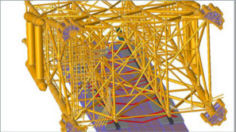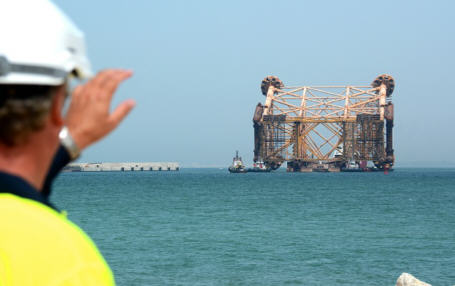|
Giant Mariner jacket
designed for longevity, stability in severe
storms
By Jeremy Beckman, Offshore Magazine
Aug. 19, 2015 + + + This summer Saipem
is due to launch and install the jacket for the Mariner field platform
east of the Shetland Isles. The $7-billion project is the largest current
greenfield development in the UK North Sea, and Statoil’s first as
operator in the UK sector.
The 22,400-ton jacket and the 54,000-ton topsides, to be installed next
spring, will form the production, drilling, and quarters platform, with
produced oil stored on a floating storage unit alongside for offloading to
a shuttle tanker. Statoil aims to start production in early 2017 and to
keep the field in production for 30 years.
Shortly before receiving
formal UK government approval for the project in early 2013, Statoil
awarded engineering, procurement, and construction contracts to Dragados
to build the jacket in southwest Spain and to Daewoo in South Korea for
the topsides. SNC-Lavalin’s division in the UK, which had earlier
performed front-end engineering and design for the jacket, also performed
detailed design of the structure, working in close cooperation with
Dragados.
David Maclaren, head of Structures–Offshore at SNC-Lavalin,
outlined the main engineering issues for the jacket at Bentley’s Year in
Infrastructure conference in London late last year. The engineering team
adopted Bentley’s SACS and STAAD.Pro software for 19 interrelated analyses
of structural strength requirements in different scenarios and for
detailed design of secondary steel components. The topsides designer Aker
Solutions used the same software, and both parties shared their models and
analyses throughout the construction process with the jacket and topsides
fabricators, another engineering center in India, and third-party
verification specialists in London and Norway.
Texaco originally
discovered Mariner in the 1980s. Recoverable reserves are estimated at 250
MMbbl, but the combination of heavy oil and complex reservoirs ruled out
development until technologies finally emerged to make production
economic. Statoil’s solution involves importing lighter crude mixed with
water into a diluent and installing electric submersible pumps into the
wells in order to drive the oil out. The jacket will feature 60 conductors
which could eventually accommodate 80 production wells and more than 60
water re-injectors.
Aside from the conductors, the jacket will be
connected to three risers and 16 caissons, with 13 j-tubes to connect
future risers and umbilicals. “It’s a really massive structure,” Maclaren
said, “connected to the seabed by 24 piles, all 8-in. diameter,
penetrating 400 m [1,312 ft] below the seabed and connected via
traditional grouted connections.
“To design this kind of structure we
need to perform a huge number of different analyses, all of which
interrelate to each other, and the complexity of that means we have to
repeat the analysis after each one is completed. We then have to go back
and recycle some of our other analyses and use Bentley’s suite of SACS
programs to perform further analysis.”
The priority is to cover all
eventualities once the jacket is in place, including whether it can
survive a 100-year storm in the area without progressive collapse,
Maclaren said. “In this case, that means 27-m [89-ft] peak-trough waves –
equivalent to seven stories high – passing through the structure. That’s
what we have to simulate in our design, ensuring that the forces are not
excessive and that the braces are all adequate for purpose.”
The jacket
is engineered to survive 40 years without further recourse to repairs for
fatigue damage. This entails analysis of each individual element,
effectively to ensure survival for 400 years in some cases, Maclaren
explained, equivalent to a factor of 10 in fatigue life. “We also have to
look at the 10,000-year storm scenario to ensure the structure doesn’t
collapse.”
Load-out stresses
 For load-out of the completed jacket
from Dragado’s yard in Puerto Real, SNC-Lavalin’s team built a SACS model
of the structure in a horizontal position. This took into account
potential stresses along the load-out grillage; the load-out beams on the
bottom; and the forces acting on the jacket during its subsequent voyage
on a transportation barge, pulled by tugs and ballasted to a certain level
within the water. In this case, the route takes in the Bay of Biscay off
northern Spain and the English Channel, before continuing up the North
Sea. “It’s quite a long tow,” Maclaren said, “so we have to design for
that worst-case scenario.” For load-out of the completed jacket
from Dragado’s yard in Puerto Real, SNC-Lavalin’s team built a SACS model
of the structure in a horizontal position. This took into account
potential stresses along the load-out grillage; the load-out beams on the
bottom; and the forces acting on the jacket during its subsequent voyage
on a transportation barge, pulled by tugs and ballasted to a certain level
within the water. In this case, the route takes in the Bay of Biscay off
northern Spain and the English Channel, before continuing up the North
Sea. “It’s quite a long tow,” Maclaren said, “so we have to design for
that worst-case scenario.”
“Once at the site, we then have to launch
from the barge into the water [using SACS’ launch model]. This is one of
the most nerve-wracking moments for an engineer, because we want to ensure
that when we launch the jacket it floats and doesn’t get too close to the
seabed, which is relatively close in this case.” The jacket is 135 m (443
ft) tall, while the water depth at the location is 110 m (361 ft).
“The
jacket will be upended from a heavy-lift vessel. We analyze the different
stages of the upending sequence with slings added to the model between the
hook point and the jacket lift point…ensuring only the axial load is
carried.”
According to Maclaren, both the third-party verification
company and an independent competent persons’ report confirmed that the
design achieved a high level of utilization in the jacket, allowing
SNC-Lavalin to minimize wastage of materials and reduce project cost. “The
installation risk was also mitigated by using SACS to design the
installations systems and the structural launch analysis. The redundancy
analysis allowed our engineers to… ensure accelerated impact scenarios
would not cause the overall structure to fail; and the safety of the
design was demonstrated by conducting simulated blast analysis and
non-linear analysis such as bolt impact.”
“The long-term integrity of
the structure is provided by ensuring the detailed fatigue and fracture
mechanisms assessment and providing adequate corrosion protection to
ensure integrity for the 40-year life of the platform.”
Source: Jeremy Beckman, Editor Europe, Offshore Magazine
www.offshore-mag.com
|
 Worldwide more than Worldwide more than
100,000 paid subscriptions
Since May 2015
Oil, Gas &
Petrochem (OG&PE) is published as part of the
OIL & GAS
JOURNAL to serve a consolidated monthly audience of 135,000 oil/gas professionals worldwide
»
read more |

Worldwide
more than 48,000 subscriptions -
100% one-year direct request
qualification

'What's New' in Upstream, Midstream and
Downstream Products & Services. Circulation 37,000
PennWell
Petroleum Group:
Oil & Gas Journal
Oil & Gas Journal Russia
OGJ_eNewsletter
OGJ-Website-Statistics
Oil, Gas & Petrochem Equipment
Offshore Magazine
Offshore
Russia
Offshore eNewsletter
Offshore
Website Statistics
Oil & Gas Financial Journal
+ + +
For more information, media
kits or
sample copies please contact
Andreas
Sicking
+49 (0)2903-338570
wilhelms@pennwell.com
www.sicking.de
|

 For load-out of the completed jacket
from Dragado’s yard in Puerto Real, SNC-Lavalin’s team built a SACS model
of the structure in a horizontal position. This took into account
potential stresses along the load-out grillage; the load-out beams on the
bottom; and the forces acting on the jacket during its subsequent voyage
on a transportation barge, pulled by tugs and ballasted to a certain level
within the water. In this case, the route takes in the Bay of Biscay off
northern Spain and the English Channel, before continuing up the North
Sea. “It’s quite a long tow,” Maclaren said, “so we have to design for
that worst-case scenario.”
For load-out of the completed jacket
from Dragado’s yard in Puerto Real, SNC-Lavalin’s team built a SACS model
of the structure in a horizontal position. This took into account
potential stresses along the load-out grillage; the load-out beams on the
bottom; and the forces acting on the jacket during its subsequent voyage
on a transportation barge, pulled by tugs and ballasted to a certain level
within the water. In this case, the route takes in the Bay of Biscay off
northern Spain and the English Channel, before continuing up the North
Sea. “It’s quite a long tow,” Maclaren said, “so we have to design for
that worst-case scenario.”
